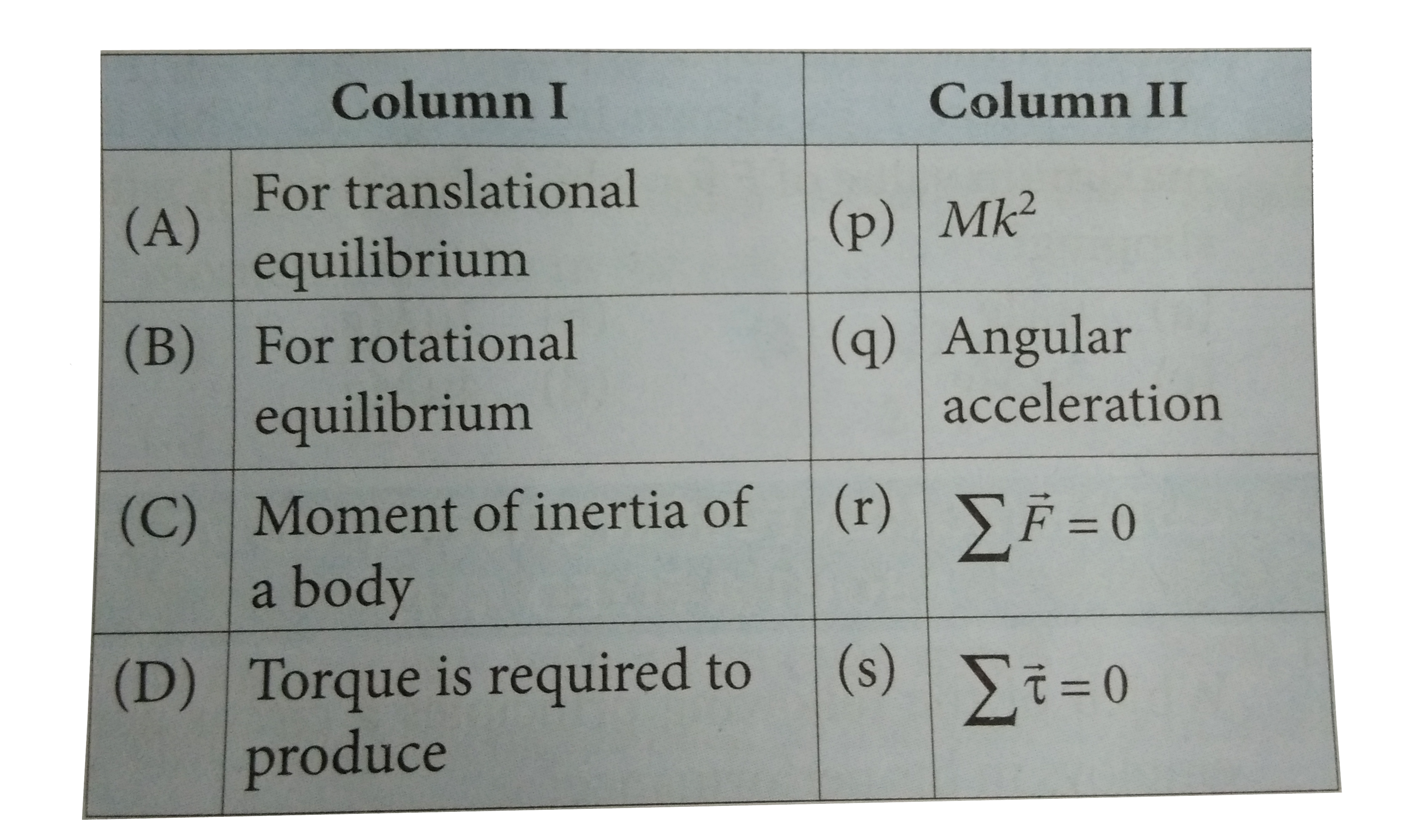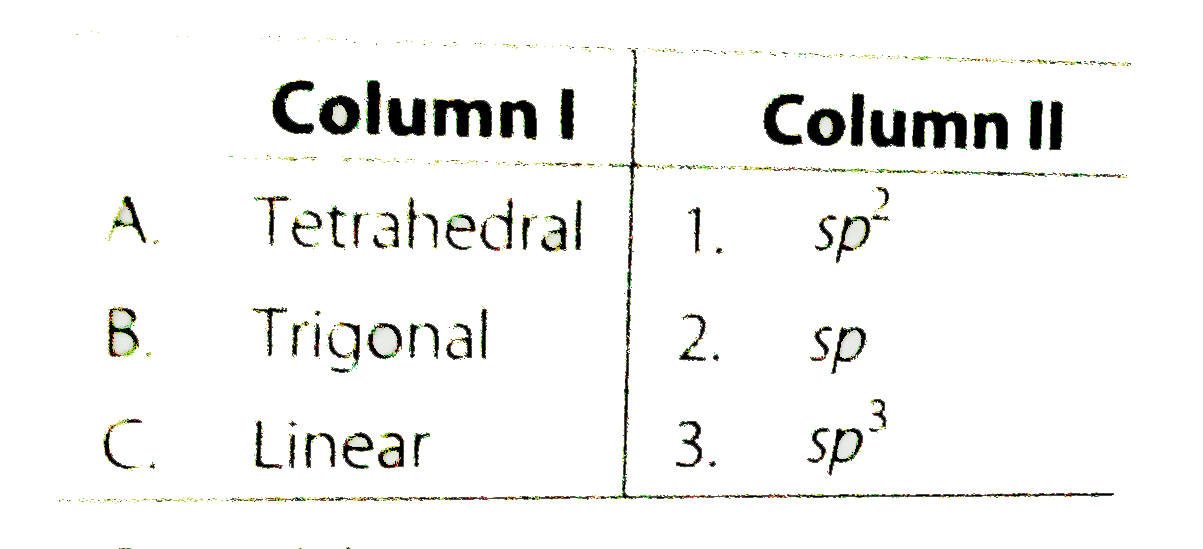Match the shape of molecules in Column 1 with the type of hybridisation in Column II.
Column IColumn II(a)Tetrahedral(i)sp2(b)Trigonal(ii)sp(c)Linear(iii)sp3(d)Trigonal bipyramidal(iv)sp3d
The correct Answer is:(a) - (iii) ; (b) - (i) ; ( c) - (ii) ; (d) - (iv)
To solve the problem of matching the shapes of molecules with their corresponding types of hybridization, we can follow these steps:
Step 1: Identify the Shape and Hybridization of Each Molecule
1. Tetrahedral (a):
- Example: Methane (CH₄)
- Central atom: Carbon (C)
- Valence electrons of C: 4
- Number of monovalent atoms (H): 4
- Hybridization calculation:
H=12(Valence electrons+Monovalent atoms+Charge)=12(4+4+0)=82=4
- Hybridization: sp³
2. Trigonal Planar (b):
- Example: Boron Trichloride (BCl₃)
- Central atom: Boron (B)
- Valence electrons of B: 3
- Number of monovalent atoms (Cl): 3
- Hybridization calculation:
H=12(3+3+0)=62=3
- Hybridization: sp²
3. Linear (c):
- Example: Beryllium Dichloride (BeCl₂)
- Central atom: Beryllium (Be)
- Valence electrons of Be: 2
- Number of monovalent atoms (Cl): 2
- Hybridization calculation:
H=12(2+2+0)=42=2
- Hybridization: sp
4. Trigonal Bipyramidal (d):
- Example: Phosphorus Pentachloride (PCl₅)
- Central atom: Phosphorus (P)
- Valence electrons of P: 5
- Number of monovalent atoms (Cl): 5
- Hybridization calculation:
H=12(5+5+0)=102=5
- Hybridization: sp³d
Step 2: Match the Shapes with Hybridizations
Now that we have determined the hybridizations for each shape, we can match them:
- (a) Tetrahedral → (iii) sp³
- (b) Trigonal Planar → (i) sp²
- (c) Linear → (ii) sp
- (d) Trigonal Bipyramidal → (iv) sp³d
Final Matches
- a → iii
- b → i
- c → ii
- d → iv
Summary of the Matches:
- (a) Tetrahedral → (iii) sp³
- (b) Trigonal Planar → (i) sp²
- (c) Linear → (ii) sp
- (d) Trigonal Bipyramidal → (iv) sp³d
---
- Example: Methane (CH₄)
- Central atom: Carbon (C)
- Valence electrons of C: 4
- Number of monovalent atoms (H): 4
- Hybridization calculation:
H=12(Valence electrons+Monovalent atoms+Charge)=12(4+4+0)=82=4
- Hybridization: sp³
- Example: Boron Trichloride (BCl₃)
- Central atom: Boron (B)
- Valence electrons of B: 3
- Number of monovalent atoms (Cl): 3
- Hybridization calculation:
H=12(3+3+0)=62=3
- Hybridization: sp²
- Example: Beryllium Dichloride (BeCl₂)
- Central atom: Beryllium (Be)
- Valence electrons of Be: 2
- Number of monovalent atoms (Cl): 2
- Hybridization calculation:
H=12(2+2+0)=42=2
- Hybridization: sp
- Example: Phosphorus Pentachloride (PCl₅)
- Central atom: Phosphorus (P)
- Valence electrons of P: 5
- Number of monovalent atoms (Cl): 5
- Hybridization calculation:
H=12(5+5+0)=102=5
- Hybridization: sp³d
- (b) Trigonal Planar → (i) sp²
- (c) Linear → (ii) sp
- (d) Trigonal Bipyramidal → (iv) sp³d
- a → iii
- b → i
- c → ii
- d → iv
- (a) Tetrahedral → (iii) sp³
- (b) Trigonal Planar → (i) sp²
- (c) Linear → (ii) sp
- (d) Trigonal Bipyramidal → (iv) sp³d
Similar Questions
Knowledge Check
Match the Column I and Column II.,B
 AA-p, B-q, C-r, D-sBA-q, B-r, C-s. D-pCA-r, B-q, C-p, D-pDA-r, B-s, C-p, D-q
AA-p, B-q, C-r, D-sBA-q, B-r, C-s. D-pCA-r, B-q, C-p, D-pDA-r, B-s, C-p, D-q
Match the items given in Column 1 with examples give in Column II.
Column IColumn II(a)Hydrogen bond(i)C(b)Resonance(ii)LiF(c)Ionic solid(iii)H2(d)Covalent solid(iv)HF(v)O3
View SolutionMatch the species given in Column I with hybridisation given in Column II.
Column-IColumn-IIA.Boron in[B(OH4)]−1.sp2B.Aluminium in[Al(H2O)6]3+2.sp3C.Boron in B2H63.sp3d2D.Carbon in buckminster fullereneE.Silicon in SiO4−4F.Germanium in[GeCl6]2−
View SolutionMatch the following column I with column II and choose the correct combination.
ColumnIColumnII(a)Earthworm(i)Gizzard(b)Cockroach(ii)Caecum(c)Frog(iii)Clitellum(d)Rat(iv)Cloaca
View SolutionMatch the column I with Column II:-
Column IColumn II(A) Unicellular(i) Spirogyra(B) Colonial(ii) Kelps(C) Filamentous(iii) Volvox(D) massive plant bodies(iv) Chlamydomonas
View SolutionMatch the columns
Column-AColumn-B(a)Ribs(i)26(b)Vertebrae(ii)14(c)Phalanges(iii)1(d)Sternum(iv)24
View SolutionWhy is a molecule involving sp2 hybridisation trigonal and planar?
View SolutionMatch the compounds listed in column I with characteristic listed in column II.
Column-IColumn-II(A)B2H6(p)Tetrahedral hybridisation(B)Al2Cl6(q)Trigonal planar hybridisation(C)BeCl2(s)(r)Empty orbital of central atom participate in hybridisation(D)(SiH3)3N(s)Two types of bonds(t)Two type of bond angles
View Solution
